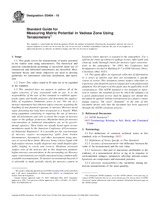Potřebujeme váš souhlas k využití jednotlivých dat, aby se vám mimo jiné mohly ukazovat informace týkající se vašich zájmů. Souhlas udělíte kliknutím na tlačítko „OK“.
ASTM D3404-15
Standard Guide for Measuring Matric Potential in Vadose Zone Using Tensiometers (Withdrawn 2024)
Automaticky přeložený název:
Standardní Průvodce pro měření Vodní potenciál v Vadose Zone pomocí tensiometers
NORMA vydána dne 15.4.2015
Informace o normě:
Označení normy: ASTM D3404-15
Poznámka: NEPLATNÁ
Datum vydání normy: 15.4.2015
Kód zboží: NS-588492
Počet stran: 13
Přibližná hmotnost: 39 g (0.09 liber)
Země: Americká technická norma
Kategorie: Technické normy ASTM
Kategorie - podobné normy:
Anotace textu normy ASTM D3404-15 :
Keywords:
manometer, matric potential, porous cup, pressure sensor, soil water, tensiometer, vacuum gauge, vadose zone,, ICS Number Code 07.060 (Geology. Meteorology. Hydrology)
Doplňující informace
| Significance and Use | ||
|
5.1 Movement of water in the unsaturated zone is of considerable interest in studies of hazardous-waste sites 5.2 If the moisture-characteristic curve is known for a soil, matric-potential data can be used to determine the approximate water content of the soil (10). The standard tensiometer is used to measure matric potential between the values of 0 and -867 cm of water; this range includes most values of saturation for many soils 5.3 Tensiometers directly and effectively measure soil-water tension, but they require care and attention to detail. In particular, installation needs to establish a continuous hydraulic connection between the porous material and soil, and minimal disturbance of the natural infiltration pattern are necessary for successful installation. Avoidance of errors caused by air invasion, nonequilibrium of the instrument, or pressure-sensor inaccuracy will produce reliable values of matric potential. 5.4 Special tensiometer designs have extended the normal capabilities of tensiometers, allowing measurement in cold or remote areas, measurement of matric potential as low as -153 m of water (-15 bars), measurement at depths as deep as 6 m (recorded at land surface) for conventional tensiometers, depths up to 200 m and greater with advanced and portable versions (5.5 Pressure sensors commonly used in tensiometers include vacuum gauges, mercury manometers, and pressure transducers. Only tensiometers equipped with pressure transducers allow for the automated collection of large quantities of data. However, the user needs to be aware of the pressure-transducer specifications, particularly temperature sensitivity and long-term drift. Onsite measurement of known zero and “full-scale” readings probably is the best calibration procedure; however, onsite temperature measurement or periodic recalibration in the laboratory may be sufficient. |
||
| 1. Scope | ||
|
1.1 This guide covers the measurement of matric potential in the vadose zone using tensiometers. The theoretical and practical considerations pertaining to successful onsite use of commercial and fabricated tensiometers are described. Measurement theory and onsite objectives are used to develop guidelines for tensiometer selection, installation, and operation. 1.2 Units—The values stated in SI units are to be regarded as the standard. 1.3 This standard does not purport to address all of the safety concerns, if any, associated with its use. It is the responsibility of the user of this standard to establish appropriate safety and health practices and determine the applicability of regulatory limitations prior to use. The use of a mercury manometer has inherent safety concerns regarding the handling of and potential exposure to mercury. Mercury metal vapor poisoning has long been recognized as a hazard. When using equipment containing or requiring the use of mercury, take all precautions and care to avoid the escape of mercury vapor or the spillage of mercury. Maximum limits for mercury concentrations in industrial atmospheres are set by governmental agencies. These limits are usually based upon recommendations made by the American Conference of Governmental Industrial Hygienists*. It is possible for the concentration of mercury vapors accompanying spills from broken thermometers, barometers, and other instruments using mercury to exceed these limits. Mercury, being a heavy liquid with high surface tension, readily disperses into small droplets after spills, lodging in cracks and crevices. Resultant increased surface area of the mercury due to this dispersion promotes higher mercury concentrations in the surrounding air. Mercury vapor concentrations are readily measured using commercially available instrumentation. To monitor environmental hazards it is advisable to make periodic checks for mercury content at locations where mercury is exposed to the atmosphere. Use a spill kit for clean-up whenever spillage occurs. After spills and clean-up, make thorough checks for mercury vapor concentrations in the atmosphere. *In 1993, this Conference had headquarters located in Building D-7 at 6500 Glenway Drive, Cincinnati, Ohio 45211. 1.4 This guide offers an organized collection of information or a series of options and does not recommend a specific course of action. This document cannot replace education or experience and should be used in conjunction with professional judgment. Not all aspects of this guide may be applicable in all circumstances. This ASTM standard is not intended to represent or replace the standard of care by which the adequacy of a given professional service must be judged, nor should this document be applied without consideration of a project's many unique aspects. The word“ Standard” in the title of this document means only that the document has been approved through the ASTM consensus process. |
||
| 2. Referenced Documents | ||
|




 Cookies
Cookies
